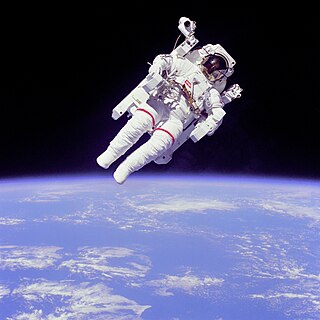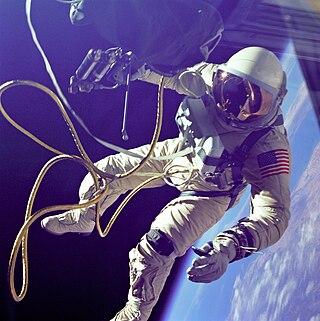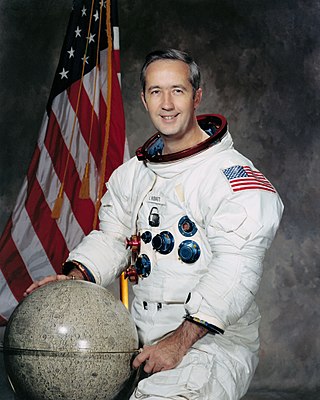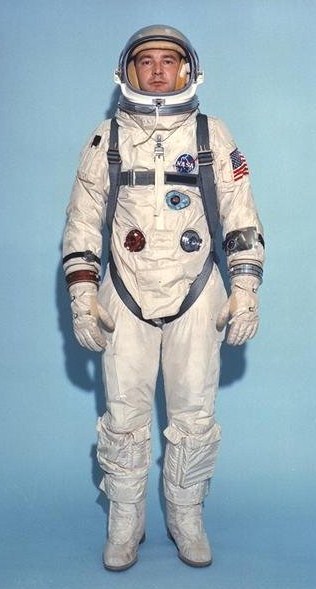
Apollo 9 was the third human spaceflight in NASA's Apollo program. Flown in low Earth orbit, it was the second crewed Apollo mission that the United States launched via a Saturn V rocket, and was the first flight of the full Apollo spacecraft: the command and service module (CSM) with the Lunar Module (LM). The mission was flown to qualify the LM for lunar orbit operations in preparation for the first Moon landing by demonstrating its descent and ascent propulsion systems, showing that its crew could fly it independently, then rendezvous and dock with the CSM again, as would be required for the first crewed lunar landing. Other objectives of the flight included firing the LM descent engine to propel the spacecraft stack as a backup mode, and use of the portable life support system backpack outside the LM cabin.

Extravehicular activity (EVA) is any activity done by an astronaut in outer space outside a spacecraft. In the absence of a breathable Earthlike atmosphere, the astronaut is completely reliant on a space suit for environmental support. EVA includes spacewalks and lunar or planetary surface exploration. In a stand-up EVA (SEVA), an astronaut stands through an open hatch but does not fully leave the spacecraft. EVAs have been conducted by the Soviet Union/Russia, the United States, Canada, the European Space Agency and China.

Gemini 10 was a 1966 crewed spaceflight in NASA's Gemini program. It was the 8th crewed Gemini flight, the 16th crewed American flight, and the 24th spaceflight of all time. During the mission, flown by future STS-1 Commander John Young and future Apollo 11 Command Module Pilot Michael Collins, Collins became the first person to perform two extravehicular activities.

Edward Higgins White II was an American aeronautical engineer, United States Air Force officer, test pilot, and NASA astronaut. He was a member of the crews of Gemini 4 and Apollo 1.

A space suit or spacesuit is a garment worn to keep a human alive in the harsh environment of outer space, vacuum and temperature extremes. Space suits are often worn inside spacecraft as a safety precaution in case of loss of cabin pressure, and are necessary for extravehicular activity (EVA), work done outside spacecraft. Space suits have been worn for such work in Earth orbit, on the surface of the Moon, and en route back to Earth from the Moon. Modern space suits augment the basic pressure garment with a complex system of equipment and environmental systems designed to keep the wearer comfortable, and to minimize the effort required to bend the limbs, resisting a soft pressure garment's natural tendency to stiffen against the vacuum. A self-contained oxygen supply and environmental control system is frequently employed to allow complete freedom of movement, independent of the spacecraft.

The Manned Maneuvering Unit (MMU) is an astronaut propulsion unit that was used by NASA on three Space Shuttle missions in 1984. The MMU allowed the astronauts to perform untethered extravehicular spacewalks at a distance from the shuttle. The MMU was used in practice to retrieve a pair of faulty communications satellites, Westar VI and Palapa B2. Following the third mission the unit was retired from use. A smaller successor, the Simplified Aid For EVA Rescue (SAFER), was first flown in 1994, and is intended for emergency use only.

Gemini 4 was the second crewed spaceflight in NASA's Project Gemini, occurring in June 1965. It was the tenth crewed American spaceflight. Astronauts James McDivitt and Ed White circled the Earth 66 times in four days, making it the first US flight to approach the five-day flight of the Soviet Vostok 5. The highlight of the mission was the first space walk by an American, during which White floated free outside the spacecraft, tethered to it, for approximately 23 minutes.

Gemini 8 was the sixth crewed spaceflight in NASA's Gemini program. It was launched on March 16, 1966, and was the 14th crewed American flight and the 22nd crewed spaceflight overall. The mission conducted the first docking of two spacecraft in orbit, but also suffered the first critical in-space system failure of a U.S. spacecraft which threatened the lives of the astronauts and required an immediate abort of the mission. The crew returned to Earth safely.

Gemini 9A was a 1966 crewed spaceflight in NASA's Gemini program. It was the seventh crewed Gemini flight, the 13th crewed American flight and the 23rd spaceflight of all time. The original crew for Gemini 9, command pilot Elliot See and pilot Charles Bassett, were killed in a crash on February 28, 1966, while flying a T-38 jet trainer to the McDonnell Aircraft plant in St. Louis, Missouri to inspect their spacecraft. Their deaths promoted the backup crew, Thomas P. Stafford and Eugene Cernan, to the prime crew. The mission was renamed Gemini 9A after the original May 17 launch was scrubbed when the mission's Agena Target Vehicle was destroyed after a launch failure. The mission was flown June 3–6, 1966, after launch of the backup Augmented Target Docking Adaptor (ATDA). Stafford and Cernan rendezvoused with the ATDA, but were unable to dock with it because the nose fairing had failed to eject from the docking target due to a launch preparation error. Cernan performed a two-hour extravehicular activity, during which it was planned for him to demonstrate free flight in a self-contained rocket pack, the USAF Astronaut Maneuvering Unit. He was unable to accomplish this due to stress, fatigue, and overheating.
A service module is a component of a crewed space capsule containing a variety of support systems used for spacecraft operations. Usually located in the uninhabited area of the spacecraft, the service module serves a storehouse of critical subsystems and supplies for the mission such as electrical systems, environmental control, and propellant tanks. The service module is jettisoned upon the completion of the mission, and usually burns up during atmospheric reentry.

James Alton McDivitt was an American test pilot, United States Air Force (USAF) pilot, aeronautical engineer, and NASA astronaut in the Gemini and Apollo programs. He joined the USAF in 1951 and flew 145 combat missions in the Korean War. In 1959, after graduating first in his class with a Bachelor of Science degree in Aeronautical Engineering from the University of Michigan through the U.S. Air Force Institute of Technology (AFIT) program, he qualified as a test pilot at the Air Force Experimental Flight Test Pilot School and Aerospace Research Pilot School, and joined the Manned Spacecraft Operations Branch. By September 1962, McDivitt had logged over 2,500 flight hours, of which more than 2,000 hours were in jet aircraft. This included flying as a chase pilot for Robert M. White's North American X-15 flight on July 17, 1962, in which White reached an altitude of 59.5 miles (95.8 km) and became the first X-15 pilot to be awarded Astronaut Wings.

Simplified Aid For EVA Rescue (SAFER) is a small, self-contained, propulsive backpack system worn during spacewalks, to be used in case of emergency only. If an untethered astronaut were to lose physical contact with the vessel, it would provide free-flying mobility to return to it. It is worn on spacewalks outside the International Space Station (ISS), and was worn on spacewalks outside the Space Shuttle. So far, there has not been an emergency in which it was needed. SAFER is a small, simplified version of the Manned Maneuvering Unit (MMU), which was used for regular maneuvering.

Project Gemini was the second United States human spaceflight program to fly. Conducted after the first, Project Mercury, and while the Apollo program was still in development, Gemini was conceived in 1961 and concluded in 1966. The Gemini spacecraft carried a two-astronaut crew. Ten Gemini crews and 16 individual astronauts flew low Earth orbit (LEO) missions during 1965 and 1966.

The Quest Joint Airlock, previously known as the Joint Airlock Module, is the primary airlock for the International Space Station. Quest was designed to host spacewalks with both Extravehicular Mobility Unit (EMU) spacesuits and Orlan space suits. The airlock was launched on STS-104 on July 14, 2001.

A space capsule is a spacecraft designed to transport cargo, scientific experiments, and/or astronauts to and from space. Capsules are distinguished from other spacecraft by the ability to survive reentry and return a payload to the Earth's surface from orbit, and are distinguished from other types of recoverable spacecraft by their blunt shape, not having wings and often containing little fuel other than what is necessary for a safe return. Capsule-based crewed spacecraft such as Soyuz or Orion are often supported by a service or adapter module, and sometimes augmented with an extra module for extended space operations. Capsules make up the majority of crewed spacecraft designs, although one crewed spaceplane, the Space Shuttle, has flown in orbit.

The Gemini spacesuit is a spacesuit worn by American astronauts for launch, in-flight activities and landing. It was designed by NASA based on the X-15 high-altitude pressure suit. All Gemini spacesuits were developed and manufactured by the David Clark Company in Worcester, Massachusetts.
A cold gas thruster is a type of rocket engine which uses the expansion of a pressurized gas to generate thrust. As opposed to traditional rocket engines, a cold gas thruster does not house any combustion and therefore has lower thrust and efficiency compared to conventional monopropellant and bipropellant rocket engines. Cold gas thrusters have been referred to as the "simplest manifestation of a rocket engine" because their design consists only of a fuel tank, a regulating valve, a propelling nozzle, and the little required plumbing. They are the cheapest, simplest, and most reliable propulsion systems available for orbital maintenance, maneuvering and attitude control.

An astronaut propulsion unit is used to move an astronaut relative to the spaceship during a spacewalk. The first astronaut propulsion unit was the Hand-Held Maneuvering Unit (HHMU) used on Gemini 4.

Charles Edward "Ed" Whitsett Jr. (1936-1993) was a USAF officer and NASA engineer specializing in solutions for effective human movement in zero gravity. The pinnacle of his work was the astronaut maneuvering unit (MMU) which enabled satellite rescue and repair. For this capability, Whitsett along with NASA, Martin Marietta, Bruce McCandless, and Walter W. Bollendonk received the 1984 Robert J. Collier Trophy for "the greatest achievement in aeronautics or astronautics in America."

















